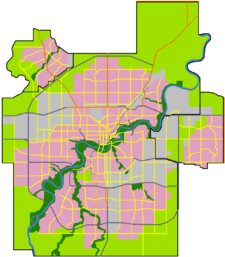- University of Alberta Hospital
-
University of Alberta Hospital Alberta Health Services 
Walter C. Mackenzie Health Science Centre Geography Location Edmonton, Alberta, Canada Coordinates 53°31′14″N 113°31′29″W / 53.52056°N 113.52472°WCoordinates: 53°31′14″N 113°31′29″W / 53.52056°N 113.52472°W Organization Care system Medicare Hospital type Research, Teaching, Children's Affiliated university University of Alberta Services Emergency department Yes Helipad TC LID: CEW7 Beds 650 History Founded 1906 Links Website University of Alberta Hospital Lists Hospitals in Canada The University of Alberta Hospital (UAH) is a research and teaching hospital in Edmonton, Alberta, Canada. The hospital is affiliated with the University of Alberta and run by Alberta Health Services, formerly Capital Health, the health authority for Alberta. It is one of Canada's leading health sciences centres, providing a comprehensive range of diagnostic and treatment services to inpatients and outpatients. The UAH has a total of 650 beds [1] and treats over 700,000 patients annually.[2]
The Stollery Children's Hospital and the Mazankowski Alberta Heart Institute are both part of the UAH, and act as embedded, "hospitals within a hospital". The Stollery Children's Hospital, along with other UAH facilities, is located in the Walter C. Mackenzie Health Sciences Centre. The Mazankowski Alberta Heart Institute is located in a new building that opened on May 1, 2008,[3] and became operational in September 2009.[4]
Because of the UAH, the surrounding area has become part of a healthcare cluster that also includes the Cross Cancer Institute, the Heritage Medical Research Building, the Zeidler Ledcor Center, the Katz Group/Rexall Center for Pharmacy and Health Research, and the upcoming Edmonton Clinic- which has been called "the Mayo Clinic of the North" and that will host many of the University's health and research clinics
The whole complex is served by the Health Sciences light rail transit station and the University Station.
Contents
History
The University of Alberta Hospital opened in 1906 with 5 staff members. Since then, it has steadily grown into a world class facility today which now is staffed by over 8,000 staff and physicians (as of 2007). The hospital began training nurses through recognized apprenticeship program in 1908. In 1916 during World War I it served as the Strathcona Military Hospital. It was the provincial rehabilitation centre for the polio epidemics in the 1920s and 1950s. Dr. Hepburn, a pioneering neurosurgeon, developed "The Edmonton Tongs" as initial treatment for cervical spine injuries in the late 1920s. Dr. John Callaghan performed Canada's first open-heart surgery here in 1956, and the first heart valve replacement 6 years later in 1962. The first heart transplant in Western Canada was performed at the hospital in 1985, by 2001 the hospital had conducted 500 heart and heart-lung transplants. In 2001 the Stollery Children's Hospital opened. In 2006, the hospital had the most technically advanced and only intensive care unit dedicated solely to the treatment of burn patients.[5]
Bob and Shirley Stollery
Around 1983 Bob and Shirley Stollery provided a generous donation that would be the catalyst for the creation of the Stollery Children's Hospital, as Edmonton's "state-of-the-art" children's hospital. The Stollerys promised to provide significant funding if such a hospital could be built. Since a "free-standing children's hospital" in the 1900s was not considered economically viable a capital fundraising campaign took place that raised over $10 million which aided in the construction of the Stollery Children's Health Centre. The Health Centre became known as the Stollery Children's Hospital in 2001 emphasizing the facility as being an independent hospital from the University of Alberta Hospital. In Alberta the Stollery is the "only provider of all pediatric complex cardiac surgical services and is the only referral center in Western Canada for pediatric heart and liver transplants". Other specialty services include pediatric and neonatal intensive care and pediatric emergency. Biomedical engineers of the hospital own the rights to SAINT, a small intensive care unit that transfers severely ill infants safely in sub-zero temperatures.
The Stollery has successfully achieved many firsts from the millions of dollars in funding over the years. The Stollery was the first hospital in Western Canada to have an Extra Corporeal Membrane Oxygenation (ECMO, a life-saving device which acts as an external heart and lungs), being able to replace a valve within a child's heart without requiring surgery, providing a pediatric intestinal transplant,and having a pediatric thrombosis program. In Canada, the Stollery had the first pediatric auto-islet transplant, and the only Weight and Health Pediatric Centre.It is also North America's first "reference centre for the Berlin Heart.
According to the official web site the vision of the hospital is:
1) That any child who becomes ill or injured receive the finest possible care in a welcoming children’s facility and
2) That the Stollery Children’s Hospital become a highly respected leader in North America in the treatment of children’s health problems.[6]In order to raise money to support funding for the children's hospital many events take place throughout the year within the city of Edmonton such as Radiothon's (local participating radio stations include CISN Country 103.9, 92.5 JOE FM and 630 CHED, The Bear 100.3, etc), Tee Up for Tots, Caring for Kids Broadcast and Snowflake Gala.
Library
The John W. Scott Health Sciences Library was opened in 1984, and was named after the Dean of Medicine from 1948-1959.[7][8]
Specialized services
Cardiac care
The University of Alberta Hospital's cardiac sciences program includes adult and pediatric cardiology and heart surgery. The program also does research in vascular biology and electrophysiology. The University of Alberta Hospital is the pioneering hospital for open-heart surgery in Canada.[9]
Transplant program
The University Hospital's transplant program is recognized as one of the best in Canada and the world. It is a leader in both the numbers of transplant procedures performed and success rates. At the hospital, patients can receive heart, lung, liver, kidney, pancreas, intestinal and islet cell transplants.[10]
Neuroscience
The University of Alberta Hospital contains a dedicated neurosciences intensive care environment. This area is dedicated to the treatment of complex conditions such as strokes, brain tumours, as well as spinal cord and brain injuries. An inter-disciplinary team uses state-of-the-art technology to coordinate the treatment of these conditions.[11]
Burn treatment
The University of Alberta Hospital receives patients from all over Western Canada in the Fire Fighter's Burn Treatment Unit. This is one of the most technologically advanced and highly acclaimed burn care units in the world. A multidisciplinary team that includes nurses, physicians and physical, respiratory, and occupational therapists provide top-quality care for burn patients.[12]
References
- ^ http://www.c2p2online.com/documents/UAH.pdf
- ^ Official Capital Health website
- ^ Large crowd greets opening of heart institute
- ^ Alberta Heart Institute
- ^ History of The University of Alberta Hospital
- ^ www.stollerykids.com/page/the stollery family.aspx The Stollery Family
- ^ A glance back in time: Two decades at the John W. Scott Health Sciences Library
- ^ J.W. Scott Health Sciences Library Website
- ^ Cardiac Care
- ^ Transplant Program
- ^ Neuroscience
- ^ Burn Treatment
Edmonton hospitals - Alberta Hospital Edmonton
- Cross Cancer Institute
- Edmonton Clinic (opening 2011)
- Glenrose Rehabilitation Hospital
- Grey Nuns Community Hospital
- Misericordia Community Hospital
- Royal Alexandra Hospital
- University of Alberta Hospital
Categories:- Hospitals in Edmonton
- Teaching hospitals in Canada
- University hospitals
- Children's hospitals in Canada
- Hospitals established in 1906
- University of Alberta buildings
- Heliports in Canada
Wikimedia Foundation. 2010.



